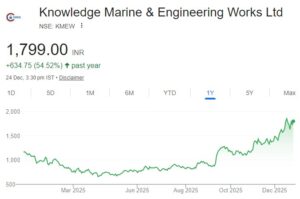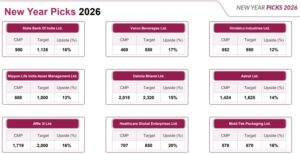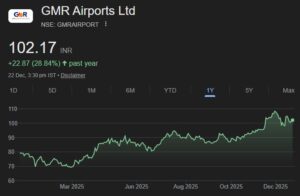
I can make more money for myself than I can as a broker
First, we have to congratulate Saurabh Mukherjea for quitting Ambit Capital and starting his own PMS Fund known as ‘Marcellus Investment Managers’.
The name “Marcellus” is inspired by Muhammad Ali, the great heavyweight boxing champion. “Marcellus” was his middle name i.e. Cassius Marcellus Clay. Marcellus also means ‘little warrior’.
Muhammad Ali had a long and very successful career. He is the only man in history to win back the world title five times over the course of 15 years.
“I figured out that I could make more money doing this for myself than I could running around the world investing, giving broking advice to others,” Saurabh said with a chuckle, making it clear that he wants to walk in the illustrious footsteps of Muhammad Ali and rake in mega bucks.
Prima facie, Saurabh’s quitting Ambit Capital is good news for us because he is now free from the antiquated rules and regulations of the broking firm.
He can now offer stock recommendations to us without any regulatory shackles.
This will help us also to effortlessly rake in multibagger gains.
Forget Mumbai, mega multibaggers will emerge out of small towns like Ludhiana, Coimbatore, Pune
Saurabh explained that if we want to home in on potential multibaggers, we will have to relinquish the comforts of mega cities like Mumbai, Delhi and Bangalore and instead brave the heat and dust of hick towns like Ludhiana, Coimbatore, Pune.
Ayesha Faridi and Tanvir Gill were not convinced with Saurabh’s theory. They stared at him with a questioning look, demanding that he give real-life examples to prove his point.
Saurabh cited four companies that have emerged from the so-called hick towns and have taken the World by storm. These are La Opala, Astral Poly, Kajaria Ceramics and Greenlam.
He explained that just ten years ago, we could have bought all four companies for a paltry market capitalisation of about Rs. 150-200 crore each.
Today, each of the four stocks is a megabagger which is much coveted by investors.
La Opala commands a market capitalisation of Rs 3,000 crore while Astral Poly demands no less than Rs 9,000-10,000 crore. The same is the story for the other two powerhouses.
Saurabh pointed out that the market capitalisation of these companies has surged because of their ability to transform themselves from regional players to national players. He said that this story is being getting replicated across numerous sectors whether it is in B2C or in B2B.
“That is going to be the big story of the next 10 years. Half the firms on BSE 500 that we see today will not be there anymore and a new bunch 250 to 300 new firms will come into that,” he said.
“That is the churn to play for. The change in a way is not so much in Mumbai or Delhi or Bangalore. The change is a little far away and that is where the really exciting opportunities are,” he added with a flourish while Ayesha Faridi and Tanvir Gill smiled, suitably impressed.
Page Industries, 100x multibagger and counting
Saurabh referred to Page Industries as the ultimately textbook example of a company that came from nowhere and created incalculable wealth for investors.
“It is the classic story of a firm which came out of nowhere 25 years ago and built a pan India brand and in the undergarment space. They started with women innerwear, men innerwear, kids and now lounge wear. They are consistently growing the business into adjacencies and ROCE are approaching 50%,” he said.
He also revealed that he holds a chunk of Page Industries in his personal portfolio and is no mood to sell it despite its alleged expensive valuations.
“It remains a holding for me. I have a remained a steadfast fan. I know it is expensive but coffee can franchises have this ability to give you 200X over 20 years and I would rather hold out for that than cash in early,” he stated.
Page Industries becomes a 100 bagger. @blitzkreigm analyses the company's journey since the time of its IPO in 2007 pic.twitter.com/phf2R5omm6
— CNBC-TV18 News (@CNBCTV18News) August 28, 2018
PAGE IND Above 36000 for the First Time
– Imp Level Why?
– IPO in 2007 at an Issue Price of 360
– So Stock is a 100 Bagger Since IPO
– Minimum lot was 15 Shares, So `5400 then is now worth `5.4 Lk @JockeyIndia @CNBCTV18News @CNBCTV18Live https://t.co/wtSv8jLUXy— Mangalam Maloo (@blitzkreigm) August 28, 2018
How to find the potential multibaggers from the micro-cap and small-cap space
Saurabh explained that while indulging in “coffee can investing”, one has to only go through the past 10 years track record and home in on stocks with 10% revenue growth and 15% ROC.
This formula ensures that only the best compounding machines fall into the net.
However, this formula does not work when one is filtering stocks which do not inhabit the BSE 500 because these small companies do not have stellar track records.
Saurabh advised that we must check whether over the past five-six years, these companies have grown the business in terms of revenues and profits.
Also, has the growth been profitable and have the profit margins improved as the businesses scaled up? And has the growth come from internal funding rather than having to rely on QIPs and bank debt?
He emphasized that if the three criteria of consistent growth, self-funded growth and growth accompanied by margin expansion and profitability expansion are met, we can short-list the Company and investigate further.
We have to then have meetings with management and track people who know the company, distributors, dealers and get a fix on the quality of the management.
Saurabh also pointed out that at any given point in time, there are around 15 to 30 companies who comfortably fit into this slot and so we have plenty to choose from.
Theory is fine. Give us names of some stocks
Nikunj Dalmia knows that one has to strike the iron when it is hot.
“Give us some names of stocks which are on the path of transformation from mini to mega,” he blurted out when Saurabh was midway through his exposition.
Saurabh cited the example of Amrutanjan Health Care, a micro-cap (Rs. 900 crore), which is holding out against FMCG giants like Vicks and Zandu and prospering.
Amrutanjan specializes in pain balm, juices, female hygiene products etc and has a stranglehold in Odisha, Bengal and south India.
“They are so strong that the Zandus and the Vicks of the world have not been able to dislodge them,” Saurabh said with awe in his voice.
Saurabh explained that Amrutanjan is not only literally debt-free but has land which itself is around a third to half of the market cap. The ROCEs are impressive at 20-21% or 15-20% growth and it has a steady regional franchise.
This makes it safe as a house.
He also emphasized that the promoters intend to scale up the Company and build it into a pan-India franchise.
It is obvious that if that happens, we will have the next Vicks or Zandu in our hands.
“It is a great company … these sorts of firms look very tasty to me,” he added.
#Amrutanjan products to be sold on Amazonhttps://t.co/08nSY41GhE pic.twitter.com/pc7DiU3nuO
— Dalal Street Journal (@DSIJ) August 27, 2018
Saurabh also referred to MM Forgings as an example of a potential mega-bagger.
He pointed out that though MM Forgings is not a front-line auto ancillary player, it has a track record of steady 10- year numbers and a solid franchise in forgings. Also, two-thirds of its revenues come from exports which means that its profits due to the weakening of the rupee will surge in the coming quarters.
#OnCNBCTV18| Vidyashankar Krishnan, MD, #MMForgings says expect 60,000-65,000 tonne of output in FY19; Expect 20-25% growth on topline in FY19 @_prashantnair @_anishaj pic.twitter.com/ifvYgl2Yl2
— CNBC-TV18 News (@CNBCTV18News) June 15, 2018
IDBI CAP ON GNA AXLES & MM FORGINGS
Initiating CoverageGNA AXLES – ACCUMULATE TGT 520
Exports driven earnings growthMM FORGINGS – BUY TGT 1400
Good times ahead— SONAM MEHTA (@sonamcnbcawaaz) April 10, 2018
High RoE companies are cash machines. Never sell them
If you have a good structural holding in your portfolio such as Page Industries or an Asian Paints, history shows that it has been folly to trade in and out of it, Saurabh said in a somewhat stern tone.
“I have tried to time it myself before giving up. It does not work,” he added emphatically.
He also pointed out that on the point on valuation ‘return on capital’ employed is the critical metric and not ‘earnings growth’.
“If you sell a company with ROC, you are basically giving up a cash machine,” he said in simple terms implying that it is ultimate buffoonery to squander away such companies.
How to build a winning portfolio
Saurabh also offered a quick 101 on portfolio construction.
He advised that one part of the portfolio should consist of structural plays whether it is coffee can type structural plays or high quality small-cap companies with a great future.
This should be the core of the portfolio which one should hold passively, without much tinkering.
The other part of the portfolio can hold opportunistic plays on the macro cycle.
For example, if one is gung ho about the rupee depreciating, he or she can tuck into stocks which will benefit from the same such as Info Tech, Pharma, auto exporters etc.
These stocks can be freely bought and sold whenever we feel the itch to tinker.
Conclusion
Saurabh Mukherjea’s theory about mega-baggers emerging from mofussil towns is very interesting. We need to keep red alert for stocks which exhibit the criteria underlined by Saurabh and grab them with both hands whenever the opportunity arises!







Just Buy sufficient size companies of market cap around 10000 Crores which are growing at 15% or more in revenue and profits and ride them upto market cap of one lakh Crore. You will find large no of safe and steady bets. Even no harm in remaining invested in all those Nifty stocks which can grow in Double Digit for next 5 years.
but it is very difficult to find out in this euphoria type , do u see?
Congratulations to Mr. Mukherjea …good to see him after a very long time…may the boarders here kindly suggest any multi-bagger for investment in the next 3-5 years
not much upside right now, with Amrutanjan PE at ~50